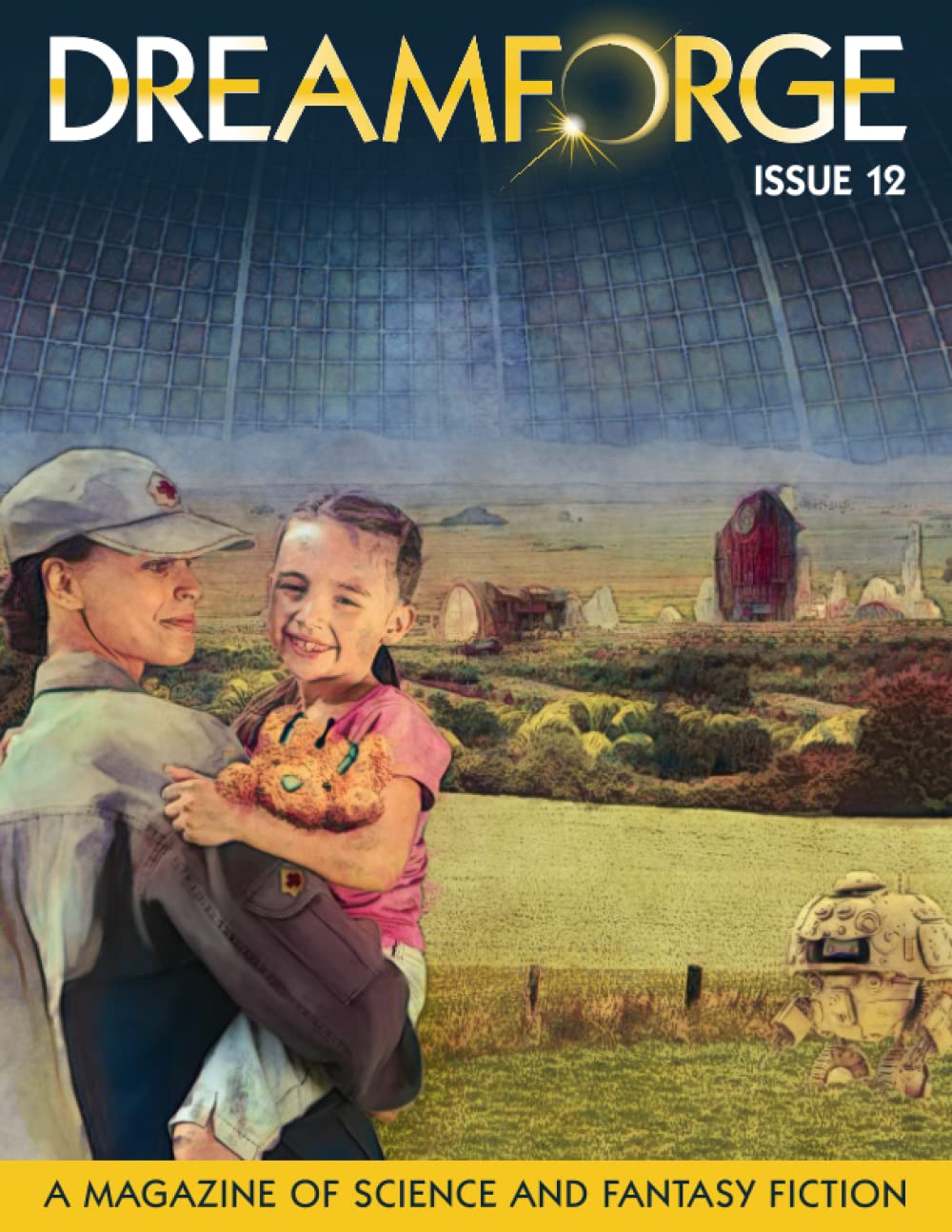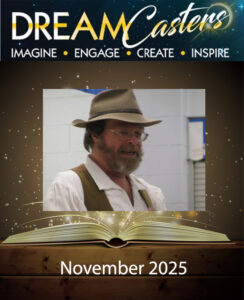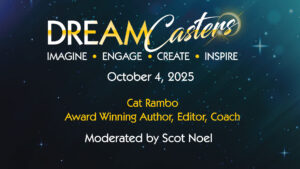DreamCasters Agenda, September 2023

09-02-2023
Opening Statement
Welcome to DreamCasters, a DreamForge discussion group devoted to helping our members improve their writing and storytelling through discussion and sharing expertise.
DreamForge News
Remaining Dates for 2023
Oct 8 | Nov 5 | Dec 3
DreamCaster Member News
We’ll ask for any publication news and if the members who were trying to submit to the Singapore based Dyson Sphere contest made the deadline.
From Akis Linardos, recent sales are:
- Flame Tree’s Learning to be Human anthology – “My Ship Remains” (3k words)
- Drabblecast Weird West Micro Fiction Contest – “In the Crevice of His Pasture, My Master Found his Body Parts”
- Solarpunk Mag Micro Fiction Contest – “Life Blooms with a Bang”
- Space & Time – first poetry sale! “Words like Worms”
- The Colored Lens – “Solar-powered Buddies” (3k words, you might remember this one, you held on to it last year)
Our Program
New Resource found after this was posted: Martin Shoemaker’s OPINION on the Unwritten Rules of writing a story for the WoTF Contest.
With so many DreamCasters regularly placing on the Writers of the Future Silver Honorable Mention and Honorable Mention lists, let’s spend a meeting talking about how to write a short story for the contest. What story qualities should you be paying attention to? What should you be sending their way.
We’ll talk about this in 2 ways. If I were asked to say “what kind of stories have a good chance of getting noticed by an honorable mention or winning Writers of the Future?” I would answer one way (see below).
What I’ll do for this meeting is try to match my answer of what should win against an actual winner – this year’s Grand Prize Golden Pen Award “White Elephant,” by David K. Henrickson.
Now, I know all of you won’t have a copy of WoTF Volume 39, but I’ll try to outline the story in a way that makes sense, even if you haven’t had a chance to read it. It should be fun.
And Here are my notes on what I would expect of a WoTF story. We’ll find out how that matches up at the meeting.
An Overview of a Good Story Structure for a WoTF Story
Story Structure:
Three-Act Structure: Classic story structure divides a narrative into three acts – Introduction, Conflict, and Resolution. Your story should have a clear beginning, middle, and end. (See details on this point below.)
Engaging Opening: The beginning of your story should grab the reader’s attention. Given that the judges will be reading many entries, this is crucial.
Climax: Ensure that your story has a moment of highest tension or a turning point. This could be an emotional revelation or a physical confrontation.
Plot:
Originality: Given the competition’s focus on speculative fiction, the more original and inventive your concept, the better. Avoid clichés or overdone tropes.
Conflict: Every story needs a central conflict. It could be external (man vs. man, man vs. nature) or internal (man vs. self). Your protagonist should face challenges and grow or change in some way.
Pacing: Ensure your story isn’t rushed or dragging. The events should unfold in a way that feels natural, compelling, and engaging.
Theme:
Depth: A theme gives depth to your story. It’s the underlying message or the big idea. Your story can be entertaining, but if it also makes readers think, it’s more likely to stand out.
Relevance: While it’s important to be original, your theme should resonate with contemporary readers. Addressing current global concerns or universal human experiences can make your work more impactful.
Subtlety: Avoid being preachy. Let your theme emerge naturally from the story, characters, and setting.
Development:
Character Development: Create multi-dimensional characters. Your protagonist should have strengths, weaknesses, desires, and fears. They should grow or change in some way by the story’s end.
World-building: Since this contest is focused on science fiction and fantasy, you should pay special attention to building a coherent and immersive world. However, avoid long expositions. Show, don’t tell.
Dialogue: Dialogue can be a tool to reveal character traits, progress the plot, or even establish the setting. Ensure it’s natural and relevant.
Additional Tips:
Follow Guidelines: Always adhere to submission guidelines. No matter how good your story, if you don’t meet the contest’s criteria, you risk disqualification.
Proofread: A story free of grammatical and spelling errors will appear more professional and polished.
Get Feedback: Before submitting, share your story with trusted friends or writing groups to get feedback and make necessary revisions.
Stay True to Your Voice: While it’s good to consider these guidelines, remember that every writer is unique. Your individual voice and perspective are your biggest strengths.
Lastly, regularly check the Writers of the Future website or their publications to get an idea of the winning entries. This will give you insights into the quality and type of stories they appreciate.
Three-Act Structure for a Short Story:
Act I: Setup
Introduction: Introduce the main characters, setting, and the initial situation. For a short story, this needs to be concise. Within a few paragraphs, readers should have a clear sense of the protagonist, the environment, and the prevailing circumstances.
Inciting Incident: This is the event that kicks off the story. It disturbs the status quo and sets the protagonist on a path or mission. In a short story, the inciting incident often occurs very quickly, sometimes even in the first few lines.
Act II: Confrontation
Rising Action: This is where the main character faces a series of obstacles or challenges. These obstacles escalate in intensity. In a short story, you might not have space for many obstacles, but even one or two can be effective if they’re deeply meaningful or intense.
Midpoint: This can be a major turning point in the story—a revelation, a decision, or an unexpected event that changes the course of the protagonist’s journey. It adds complexity and often raises the stakes.
Climax: Near the end of Act II, the tension reaches its peak. This is the moment where the conflict becomes most intense. It’s the culmination of all the events and challenges faced by the protagonist. In a short story, this often leads directly into the resolution, given the brevity of the format.
Act III: Resolution
Falling Action: After the climax, the story begins to wind down. The immediate repercussions of the climax are dealt with. In longer narratives, this section might deal with tying up loose ends, but in a short story, this part is typically concise.
Denouement/Conclusion: The story comes to an end. We see the aftermath of the climax and understand the story’s implications. It doesn’t always mean a happy ending or even a clear resolution. Some short stories end ambiguously, leaving readers to ponder the outcome or the moral of the story.
Additional Notes:
Brevity: Remember, every word counts in a short story. Be concise but impactful. You won’t have space for lengthy exposition or side plots.
Focus on a Singular Idea: Given the limited word count, hone in on one primary idea or theme. Avoid over-complicating things.
Start Strong: Given the space constraints, dive into the action or conflict quickly. Engage the reader from the get-go.
Character Depth Over Breadth: You might not have room to develop many characters deeply, so focus on making one or two characters very compelling.
End with Impact: A memorable ending, whether it’s a twist, a revelation, or a poignant moment, can leave a lasting impression.
Summary
All of this should not sound unfamiliar. It’s just another way of looking at many of the same elements we talk about in our story templates.
Now, let’s see how many of these points “White Elephant” follows or deviates from.
Giveaway This Month!
One lucky attendee chosen at random will receive a copy of the Triangulations anthology Seven Day Weekend, which contains stories by several DreamForge authors and DreamCasters Angelique Fawns and R.J.K Lee.
In October
In October, we hope to have Herb Kauderer as our guest. Herb Kauderer is an associate professor of English at Hilbert College, holding a PhD, MFA, and five other college degrees. He is the author of eighteen books, many of which are speculative poetry. He is a past winner of the Asimov’s Readers’ Award (2016) and the Ewaipanoma Sonnet Contest (2008), has been a finalist for the Analog AnLab Readers’ Award, and received Honorable Mention in The Year`s Best Fantasy and Horror.
Attend the meeting for some cool Story Prompts!
Now Available in PRINT! Order DreamForge Magazine, Issue 12 on Amazon today.
Now Available in PRINT! Order DreamForge Magazine, Issue 11 on Amazon today.




